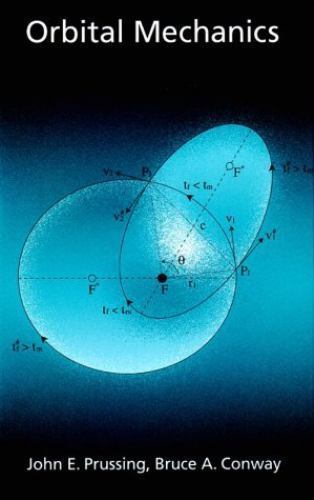Picture 1 of 1

Stock photo

Picture 1 of 1

Stock photo

Orbital Mechanics by Bruce A. Conway and John E. Prussing (1993, Hardcover)

AMA - BOOKS (4290)
96.5% positive Feedback
Price:
US $65.37
Approximately£49.21
+ $19.19 postage
Returns:
30 days return. Buyer pays for return postage. If you use an eBay delivery label, it will be deducted from your refund amount.
Condition:
Bruce A. Conway, John E. Prussing. "[Prussing and Conway] have written up their final-year university course. The book is a paragon of clarity and has problems and worked examples.". --David Hughes (Univ of Sheffield), New Scientist"Good references and problem sets." --Choice, "[Prussing and Conway] have written up their final-year university course.
Oops! Looks like we're having trouble connecting to our server.
Refresh your browser window to try again.
About this product
Product Identifiers
PublisherOxford University Press, Incorporated
ISBN-100195078349
ISBN-139780195078343
eBay Product ID (ePID)48682
Product Key Features
Number of Pages208 Pages
LanguageEnglish
Publication NameOrbital Mechanics
SubjectMechanics / Aerodynamics, Aeronautics & Astronautics
Publication Year1993
TypeTextbook
Subject AreaTechnology & Engineering, Science
AuthorBruce A. Conway, John E. Prussing
FormatHardcover
Dimensions
Item Height0.9 in
Item Weight16.2 Oz
Item Length6.4 in
Item Width9.6 in
Additional Product Features
Intended AudienceCollege Audience
LCCN92-041505
Dewey Edition20
Reviews"[Prussing and Conway] have written up their final-year university course. Here, celestial mechanics is expanded into space aeronautics. The book is a paragon of clarity and has problems and worked examples." --David Hughes (Univ of Sheffield), New Scientist"Good references and problem sets..." --Choice, "[Prussing and Conway] have written up their final-year university course. Here, celestial mechanics is expanded into space aeronautics. The book is a paragon of clarity and has problems and worked examples." --David Hughes (Univ of Sheffield), New Scientist
IllustratedYes
Dewey Decimal629.4/113
Table Of Content1. The n-body Problem2. Position in Orbit as a Function of Time3. The Orbit in Space4. Lambert's Problem5. Rocket Dynamics6. Impulsive Orbit Transfer7. Interplanetary Mission Analysis8. Linear Orbit Theory9. Determination of the Perturbed Orbit10. Orbit Determination
SynopsisOne of the major challenges of modern space mission design is the orbital mechanics -- determining how to get a spacecraft to its destination using a limited amount of propellant. Recent missions such as Voyager and Galileo required gravity assist maneuvers at several planets to accomplish their objectives. Today's students of aerospace engineering face the challenge of calculating these types of complex spacecraft trajectories. This classroom-tested textbook takes its title from an elective course which has been taught to senior undergraduates and first-year graduate students for the past 22 years. The subject of orbital mechanics is developed starting from the first principles, using Newton's laws of motion and the law of gravitation to prove Kepler's empirical laws of planetary motion. Unlike many texts the authors also use first principles to derive other important results including Kepler's equation, Lambert's time-of-flight equation, the rocket equation, the Hill-Clohessy-Wiltshire equations of relative motion, Gauss' equations for the variation of the elements, and the Gauss and Laplace methods of orbit determination. The subject of orbit transfer receives special attention. Optimal orbit transfers such as the Hohmann transfer, minimum-fuel transfers using more than two impulses, and non-coplanar orbital transfer are discussed. Patched-conic interplanetary trajectories including gravity-assist maneuvers are the subject of an entire chapter and are particularly relevant to modern space missions., As more and more spaceflights are planned and designed, students and engineers will need better and better training and some good textbooks on orbital mechanics. This text by Conway and Prussing will meet that need. For the first time, all the topics important for a complete introduction to the subject of orbital mechanics are found in a single compact book. After completing the first seven chapters, the student is able to mission, such as propellant required, time of flight, launch and arrival times, and payload., One of the major challenges of modern space mission design is the orbital mechanics -- determining how to get a spacecraft to its destination using a limited amount of propellant. Recent missions such as Voyager and Galileo required gravity assist maneuvers at several planets to accomplish their objectives. Today's students of aerospace engineering face the challenge of calculating these types of complex spacecraft trajectories. This classroom-tested textbooktakes its title from an elective course which has been taught to senior undergraduates and first-year graduate students for the past 22 years. The subject of orbital mechanics is developed starting fromthe first principles, using Newton's laws of motion and the law of gravitation to prove Kepler's empirical laws of planetary motion. Unlike many texts the authors also use first principles to derive other important results including Kepler's equation, Lambert's time-of-flight equation, the rocket equation, the Hill-Clohessy-Wiltshire equations of relative motion, Gauss' equations for the variation of the elements, and the Gauss and Laplace methods of orbit determination. The subject of orbittransfer receives special attention. Optimal orbit transfers such as the Hohmann transfer, minimum-fuel transfers using more than two impulses, and non-coplanar orbital transfer are discussed.Patched-conic interplanetary trajectories including gravity-assist maneuvers are the subject of an entire chapter and are particularly relevant to modern space missions.
LC Classification NumberTL1050.P78 1993
All listings for this product
Be the first to write a review

























